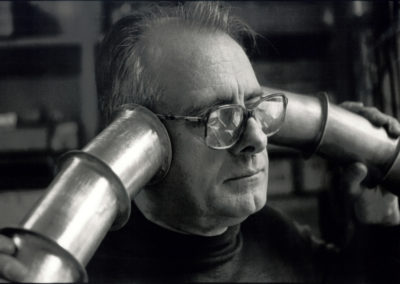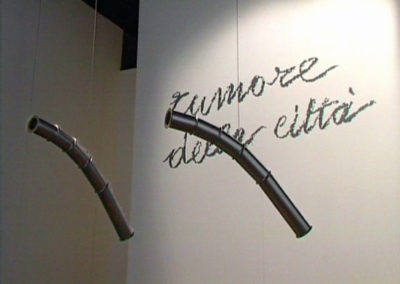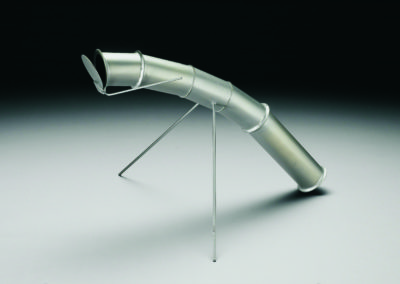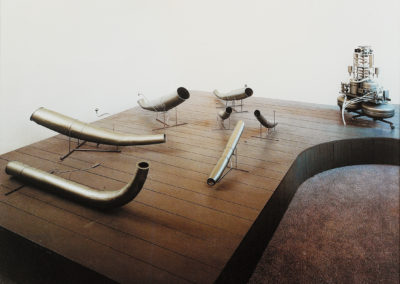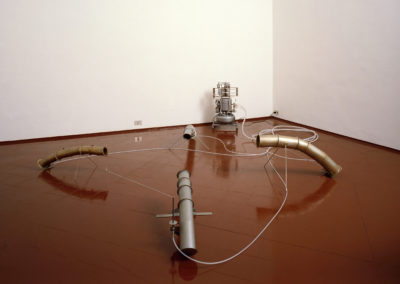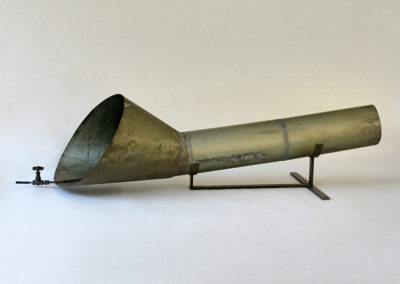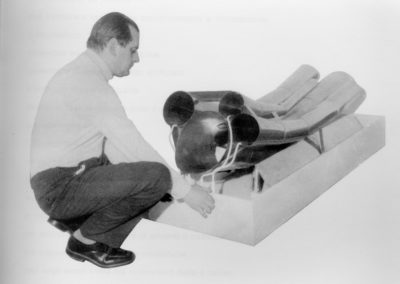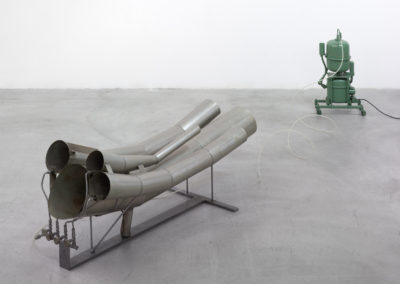HERMENEUTS (1965)
The Ermeneuti are two slightly curved nickel silver pipes, hung at a suitable height and designed to transform all external noises into a continuous, constantly changing, attractive sound. They are taken directly from the Sound Auditorium project, which, as part of the Fantastic City, was intended as an environment-instrument for correction of external noise. Inside this environment, external noise would be heard, in its full complexity, but filtered and transformed into a new and ever changing acoustic event. This would have been achieved by fitting at least one wall of the auditorium with special filters or resonators. The resonators built by Fogliati to test the possibilities were in different materials. They were pipes of various sizes, sensitive to specific frequencies. He began building various types of resonator, in different materials and sizes. The resonators were not intended as scientific devices to demonstrate resonance, but as sculptures stimulated by chaotic soundwaves, which the sculptures transformed into sound. This led to the Ermeneuti, the Liquimofono and the Latomie. The Ermeneuti have a closed end and an open end; when the open ends are placed over the ears, one can imagine the event that would have been created inside the Sound Auditorium, where the engagement with and immersion in sound would have been total. So the Ermeneuti are a representation on an “exhibition scale” of an unrealised project for an urban environment.
LATOMIE (1965)
The Latomie are very similar in shape to the Ermeneuti, but produce sound in a different way. They too are curved pipes of different sizes, but instead of being hung at a height of about six feet, they are placed on the ground. Fogliati also experimented with different shapes and materials in order to «accentuate the acoustic response by means of the shape and the materials used». Just as he had done with the construction of the filters for the wall of the Sound Auditorium, Fogliati used different materials for the Latomie. He filled them with liquids, such as water, oil and glycerine. He began developing the shapes with the intention of installing them in the Sound Auditorium, on the resonator wall, which he imagined as a sort of great fresco of sculptures that would produce sounds depending on their specific shapes. Most of the Latomie are in silver nickel, some are made from brass. The sound is obtained by means of a compressor linked to each element, which introduces air that can be regulated with taps. The sound is obtained from the interaction of the shape, the liquid and the amount of air introduced. Fogliati created a number of installations with a variety of Latomie, including the Quartet of Latomie or the Water Quartet. In this way, he says, «an installation of Latomie in different shapes and sizes generates a rich spectrum of timbres and sounds and can be adjusted to parody an orchestra of musical instruments.»
LIQUIMOPHONE(1965)
During the period when he was developing the Latomie and the Ermeneuti, Fogliati also created a sort of water organ he called Liquimofono. He describes the Liquimofono as «a single instrument with an adjustable timbre that can be used as a continuous bass. The resonators are all in curved soldered silver nickel and their different tones are generated by their shape and by the liquid inside them. They can be regulated with plumber’s taps. One resonator might contain fat, another dense oil, yet another very lightweight oil used to lubricate sewing machines, another contained glycerine.» The Liquimofono is an extension, a “liquid music generating device”, of the sound manipulation procedures created by Piero Fogliati.

